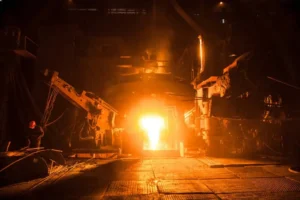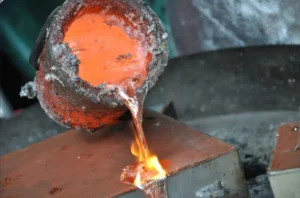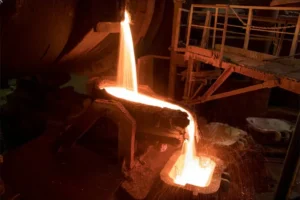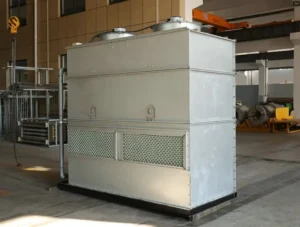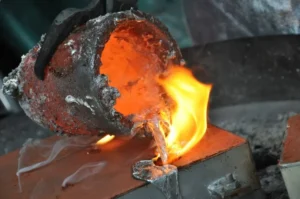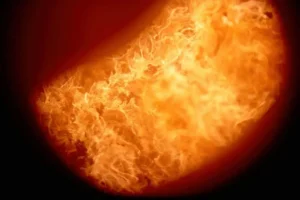ในขณะที่โลกเร่งไปสู่ความสะอาด, โครงสร้างพลังงานที่ยั่งยืนยิ่งขึ้น, new energy technologies are developing at an unprecedented pace. In this wave of energy revolution, a seemingly traditional industrial device, ที่ เตาเหนี่ยวนำ, is playing an increasingly vital role in key areas like battery materials and hydrogen storage materials, becoming the “invisible fire” driving the advancement of new energy technology.
Powering Up Battery Materials, The Advantages of Induction Sintering
From smartphones to electric vehicles, lithium-ion batteries are now ubiquitous. The core performance of these batteries is determined by their cathode and anode materials. The quality of these materials, ในทางกลับกัน, largely depends on a critical production step: การเผา.
การเผา, in simple terms, is the process of heating powdered materials at high temperatures to densify them and form a specific crystal structure. While traditional sintering often uses resistance or gas furnaces, induction heating technology is emerging as a superior alternative due to its significant advantages:
- Precise, เร็ว, and Efficient: The principle of induction heating involves using an alternating magnetic field to generate eddy currents within the material itself, causing it to “self-heat.” This method is extremely fast, significantly shortening production cycles. More importantly, because the heat is generated directly within the material, temperature control is more precise and uniform. This avoids the temperature inconsistencies common in traditional furnaces caused by heat radiation and conduction, thereby ensuring high consistency and superior electrochemical performance of battery materials.
- Energy-Saving and Eco-Friendly: Due to direct internal heating, the energy efficiency of induction furnaces is far superior to that of traditional resistance furnaces. This translates to lower energy consumption and fewer carbon emissions, perfectly aligning with the green and low-carbon development philosophy of the new energy industry.
- High-Purity Production สิ่งแวดล้อม: Induction heating requires no combustion, thus avoiding contamination from fuel impurities. An induction furnace operating under a vacuum or a specific atmosphere can provide an ideal, clean environment for sintering battery materials, especially for those with extremely high purity requirements like solid-state electrolytes.
For next-generation battery technologies such as solid-state batteries, the sintering of their core ceramic electrolytes demands even stricter control over temperature and atmosphere. ความแม่นยำและความสามารถในการควบคุมการเผาแบบเหนี่ยวนำได้เป็นวิธีแก้ปัญหาที่เหมาะ, อาจฝ่าฟันคอขวดที่สำคัญทางเทคนิคในอุตสาหกรรมของแบตเตอรี่โซลิดสเตต.
ปลดล็อกกุญแจสู่พลังงานไฮโดรเจน, ศักยภาพของเตาหลอมเหนี่ยวนำในการเตรียมวัสดุการจัดเก็บไฮโดรเจน
ไฮโดรเจนได้รับการยกย่องว่าเป็นแหล่งพลังงานสูงสุดสำหรับศตวรรษที่ 21, แต่มัน “Achilles’ ส้น” เป็นวิธีการจัดเก็บและขนส่งอย่างปลอดภัยและมีประสิทธิภาพ. วัสดุที่เก็บไฮโดรเจน, โดยเฉพาะไฮไดรด์โลหะ, ถือเป็นวิธีแก้ปัญหาที่มีแนวโน้มสูง.
เตาหลอมเหนี่ยวนำยังแสดงสัญญาที่ยอดเยี่ยมในการเตรียมโลหะผสมที่เก็บไฮโดรเจน:
- การทำให้เป็นเนื้อเดียวกันขององค์ประกอบโลหะผสม: วัสดุการจัดเก็บไฮโดรเจนประสิทธิภาพสูงจำนวนมากเป็นโลหะผสมที่ประกอบด้วยองค์ประกอบโลหะหลายชนิด. The electromagnetic stirring effect generated during induction melting promotes thorough mixing of the molten metals, ensuring the final alloy has a uniform composition. This leads to more stable and repeatable hydrogen storage performance.
- Preparation of Special Alloys: For some metals with high melting points and high reactivity, induction melting can be performed under a vacuum or protective atmosphere. This effectively prevents material oxidation and contamination, making it the ideal choice for preparing high-purity, high-performance hydrogen storage alloys. Research shows that hydrogen storage materials prepared using vacuum induction melting technology exhibit excellent storage capacity and cycle performance.
- Efficient and Flexible Production: Induction furnaces can be started and stopped quickly, ช่วยให้สามารถปรับเปลี่ยนได้อย่างยืดหยุ่นตามความต้องการในการผลิต. สิ่งนี้ทำให้พวกเขาเหมาะสมอย่างยิ่งสำหรับการผลิตชุดเล็กทั้งสองในช่วง R&เฟส D และข้อกำหนดการผลิตที่ยืดหยุ่นของการผลิตเชิงพาณิชย์ในอนาคต.
ความท้าทายและแนวโน้มในอนาคต
แม้ว่าเตาหลอมเหนี่ยวนำแสดงให้เห็นถึงศักยภาพมหาศาลในภาคพลังงานใหม่, การยอมรับอย่างกว้างขวางของพวกเขายังคงเผชิญกับความท้าทายบางอย่าง. ตัวอย่างเช่น, วัสดุฉนวนเซรามิกจำเป็นต้องใช้วิธีการทำความร้อนแบบเหนี่ยวนำทางอ้อม, และต้นทุนการลงทุนเริ่มต้นสำหรับอุปกรณ์อาจค่อนข้างสูง.
อย่างไรก็ตาม, ผลประโยชน์นั้นมีมากกว่าข้อเสีย. ในขณะที่เทคโนโลยียังคงก้าวหน้า, ความท้าทายเหล่านี้ค่อยๆเอาชนะ. ในอนาคต, เทคโนโลยีการเหนี่ยวนำความร้อนจะพัฒนาไปสู่ความฉลาดและระบบอัตโนมัติที่มากขึ้น. การรวมเข้ากับ ปัญญาประดิษฐ์ (AI) และ Internet of Things (IoT) will enable real-time monitoring and precise control of the sintering and melting processes, further enhancing product quality and production efficiency.
It is foreseeable that with the continued popularization of new energy vehicles and the gradual maturation of the hydrogen energy industry, the demand for high-performance battery materials and hydrogen storage materials will experience explosive growth. At that point, the efficient, แม่นยำ, and green technology of induction furnaces will undoubtedly play an indispensable core role in the production of new energy materials, providing a powerful and reliable “furnace fire” to build a cleaner, more sustainable energy future.


